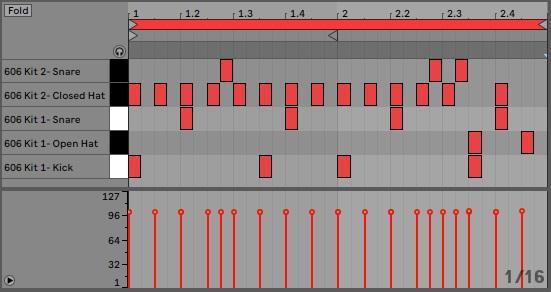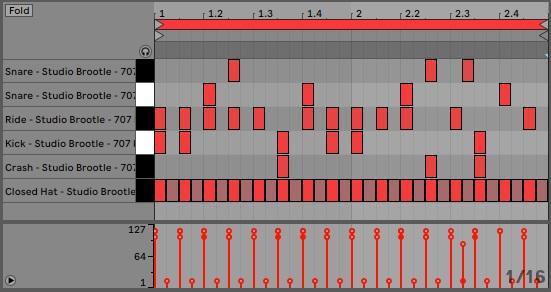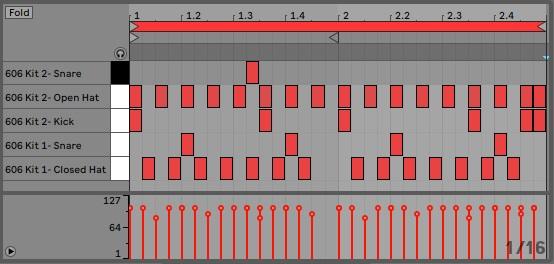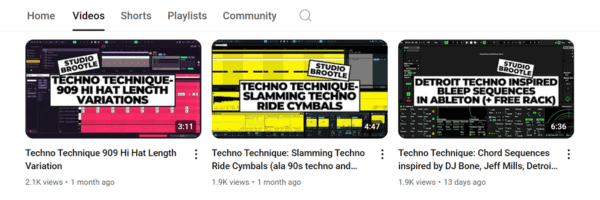Intro
Welcome to the Studio Brootle guide to drum and bass drum patterns, we run down 4 patterns including the infamous Amen Break. We cover how to program these patterns (not using sampling: that is a topic in it’s own right for another day!).
Drum and bass drums, at their basic form, often use a sampled jazz/funk/soul break and maybe kick or snare underneath it. In this article I run down how to make your own. There are a few basic patterns you should know. Obviously they can also be combined in with sampled breaks if you like.
Get our free Wavetable DNB presets here.
See also: All our drum pattern guides including How To Make Dubstep, Hip Hop Drum Patterns, UK Garage Drum Pattern, Trap Drum Patterns, Techno Drum Patterns, Electro Drum Patterns, House Drum Patterns, Studio Brootle 909 Sample Pack, Extract Groove Ableton, Free Techno Kick Sample Pack.
Tips For Programming D’n’B Drum Patterns
Here’s a few tips for programming your own dnb patterns:
- Pitch up the snares: they can sound great pitched up (as they often would have been in sampler).
- Get out of the loop: you want to get away from the sterile 1 bar loop: so if you have a small drum loop you want to double it to 2 bars and then change the second bar, normally the placement of the second kick at least, to get a 2 bar loop. You can then do the same again and change the 4th bar to keep the drums moving. You can do this on and on to keep rolling but ever changing drums.
- Adjust velocities to make things more organic. Especially when you have a lot of hats and rides in a loop you can adjust the velocities to taste to give them more of a live feel.
- Use ghost snares – use a second snare sample that is less loud than the main snares on 2 and 4 to fill up the rhythm and make it your own. Play around with different placements and see how they sound.
- If the main snare is not punchy enough you can layer a bigger snare under it, or even white noise in a sampler. Then process them together so it cuts through the mix.
- You can get your kick to cut through the mix better by making sure it has bass, mid and high end. You can do this by layering. i.e. if your kick doesn’t have enough high end you can add a clicky kick and eq it so it just has top end, and make it play at the same time as your main kick. You can process them together with compression or distortion to make them gel together and sound like one kick. Generally speaking a dnb kick should not be too subby as you want room for a huge sub bass.
- One of the things you can do, especially when starting out, is sample other producers and use their kicks and snares. And reprogram their breaks. This is a great way to learn, but you do not want to use them ‘as is’ in your tracks though, without any creativity of your own.
- Sometimes taking away is better than adding, if you have some kicks or snares in a 4 bar loop for the first 3 bars, then, when the listener is used to them, change it on the 4th bar, or take them out completely.
Drum And Bass Drum Patterns:
Here are the drum patterns transcribed, with audio, screenshots and midi clips to download…
Basic Dnb Drum Pattern

I used a simple 606 drum kit for this, you can download this kit for free here.
I added two snares, the one labeled ‘kit 2’ is the ghost snare, and is lower in volume than the main snare. I added overdrive to the main ‘kit 1’ snare to help it really hit and cut through the mix.
Feel free to change the velocities on the closed hat for a more live feel.
Drum And Bass Pattern 2

This beat uses the Studio Brootle 707 Sample Pack sample pack, you can use any you like. I like the double kick at the start. I’ve added overdrive to the main snare on 2 and 4 (1.2, 1.4, 2.2, 2.4). I also pitched up both snares 3 semitones using the transpose on Simpler. The closed hats have varying velocities for organic feel.
Drum And Bass Pattern 3

This kit is available here. This is a simple beat, with just one ghost snare (feel free to add more). The main snares are accented with added overdrive.
Amen Break Drum Pattern

Here’s the drum pattern midi for the infamous Amen break loop. There’s a 4 bar loop. Here I’ve used a simple 909 sample pack, but you can uue whatever drums you like, and edit it too. You can download the midi for this below.
Drum And Bass Drum Patterns Midi Download:
You can download the midi drum patterns for these drum n bass patterns here. It includes the midi for the Amen Break and the other 3 dnb patterns.
A Few More Things You Need To Know…
Drum n Bass BPM
Drum and bass can be anywhere from 160bpm (for older, slower tracks) to 180bpm for more modern tear out slammers! Aim for 170-175bpm and you’ll be good, or pick 2 or 3 tracks you like that are similar to what you’re working on and check their bpm.
Ghost Snares
So, what are ghost snares? In dnb you have big snares on counts 2 and 4, but you also have other normally quieter snares that add to feeling and swing of the track. These are the ghost snares.
Using Swing
Swing is important in drum n bass to give the drums a more organic and funky feel. In some cases you want a sterile, on-the-beat, robotic drums, but most of the time some swing will really help to add funk and feeling to the drums. If you’re using sampled drum breaks you can use their groove and apply it to your drums. For more on that see our guide: Extract Groove Ableton.
Using Sampled Breaks
I won’t go into how to sample, edit and use drum breaks here, that will need an entire article in it’s own right, but there are some things you should know for using sampled breaks with your own drums….
Loads of drum and bass tracks use sampled drum break(s) from jazz, funk and soul records, if using sampled breaks you should pay attention to a couple of things:
You need to add kicks and snare where they already have kicks and snares so add your own exactly where they already hit. Also the sampled drums will likely have their own swing, so you can either quantize them with the rest of the track, or you can use their groove and apply that to the rest of the drums.
Before You Go…
- Get on the email list for free kick drum samples every week, plus you get all the past ones as soon as you subscribe: you can do that HERE.
- You can find our paid packs at our Shopify store HERE ( use this code for 60% off anything or everything: SBCOM60STWD ) .
- Follow us on Youtube for hardware workouts and Ableton tutorials… Studio Brootle Youtube.
- If you’re looking for 1 to 1 online Ableton lessons get in contact to get the most out of your studio time, email: studiobrootle@gmail.com.
